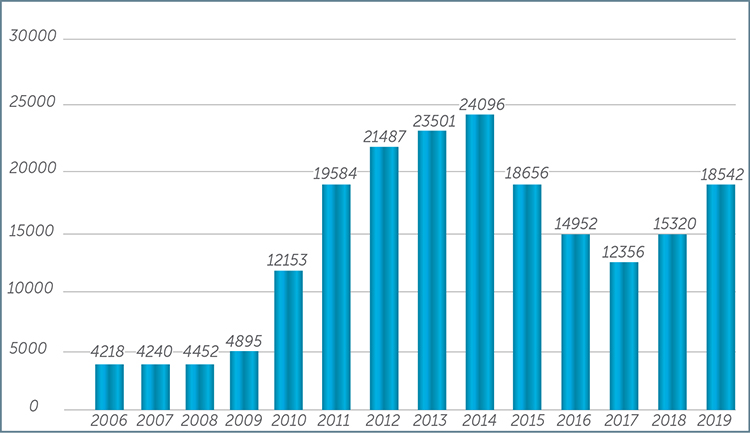Tapping into commercial aquaculture opportunities in Kenya
At a glance
- Aquaculture in Kenya has evolved from subsistence farming to a commercially viable activity involving the sale of farmed fish. It contributed to 12.8% of the country's fish output in 2019, offering an alternative to fish from capture fisheries.
- Freshwater aquaculture dominates fish farming in Kenya, with tilapia being the main species produced. There is potential for the sector to contribute to food security, livelihood diversification, employment, income generation, and poverty alleviation.
- After a decline in aquaculture production from 2014 to 2017, supportive laws, policies, and sustainable production systems have led to an upward trajectory. Investing in aquaculture can help meet the increasing demand for fish in Kenya due to population growth and awareness of its nutritional benefits.
According to a 2021 report by the Kenya Marine and Fisheries Research Institute on the State of Aquaculture in Kenya, the sector contributed to 12,8% of the country’s fish output in 2019 and is increasingly growing in significance as a viable alternative to the supply of fish from capture fisheries. This is especially important as the maximum sustainable yields in most rivers and lakes in Kenya have been exceeded, and output has stagnated.
Currently, freshwater aquaculture dominates fish farming in Kenya, with mariculture remaining less developed. Tilapia (mainly oreochromis niloticus) is the main species produced. However, there is also some farming of the African catfish (clarias gariepinus) and the rainbow trout (oncorhynchus mykiss). Although production is predominantly for food, there is also increasing production of baitfish and ornamental fish. The aquaculture sector therefore has the potential to not only contribute to food and nutrition security, but is also crucial for diversifying livelihoods, creating employment, generating income and alleviating poverty.
Aquaculture production in Kenya had been on an upward trend but tumbled from highs of 24,096 metric tonnes in 2014 to a low of 12,356 metric tonnes in 2017. This rapid decline was attributed to the conclusion of the Fish Farming Enterprise Program that was launched as a key pillar in the 2009–2013 Economic Stimulus Program by the Government, with the aim of revitalising the economy through the injection of capital to key sectors. However, since 2017, supportive laws and policies and the use of highly productive but sustainable systems in fish production have progressively contributed to an upward trajectory in fish production.
Investing in aquaculture has the potential to ensure domestic fish supply satisfies the high demand envisioned to arise from Kenya’s population increase (67 million by 2030), and a heightened awareness of the nutritional benefits of fish in the country. To tap into the vast opportunities in the aquaculture sector, it is important to be aware of the following key legal requirements.
Establishing a commercial aquaculture farm
Registration
Under the Fisheries Management and Development Act, 2016 (Act), any person who wishes to have an aquaculture establishment must have it registered with the Director General of the Kenya Fisheries Service (Director General).
The information provided to the Director General for purposes of registering an aquaculture establishment includes a full description of the establishment and the name of the operator. In the event of transfer of an aquaculture establishment, the buyer or transferee is required to give notice of such transfer to the Director General within 14 days after the sale or transfer.
Licensing
A person desirous of establishing an aquaculture farm is required to submit an application for a licence to the Director General. Upon receipt of an application, the Director General assesses the financial and technical ability of the applicant, the fish species sought to be farmed, and the method of farming to be employed.
Provision of accurate and proper information on the application is critical under the Act, as where more than one person makes an application on the same site or part of a site, preference is given to the person whose application appears to be the best, based on the information provided in the licence application.
A licence applicant is also required to ensure public notice of the application and compliance with environmental standards, such as on environmental impact assessment, as a prerequisite to obtaining a licence.
Conditions under the licence
The Director General may impose certain conditions on the licence relating to the siting, design, equipment, and materials to be used in the construction of an aquaculture establishment and pollution and water quality control of the establishment, among other things.
Another key condition contained in an aquaculture licence is that the establishment must be undertaken within the prescribed timeframe, failing which the Director General is entitled to revoke it.
Provision of false information in a licence application or failure to comply with conditions imposed in a licence may lead to the cancellation or suspension of the licence by the Director General.
Rights granted under the licence
The licence to establish an aquaculture farm grants a licensee the right to use the identified parcel of land, premise, or structure to undertake commercial aquaculture. It further grants the holder exclusive rights to harvest the products of the relevant aquaculture establishment within the area specified in the licence.
The licence will be issued for a term not exceeding 10 years and is subject to renewal on an annual basis.
Operating obligations
Persons engaged in aquaculture activities are required to keep accounts, records, documents relating to their activities and any data that may be required by the Director General. They are also required to take appropriate measures to prevent or minimise the risk of the escape of aquaculture stock into the wild and ensure proper management of aquaculture waste.
Operators of commercial aquaculture establishments are also prohibited from using any drug, pharmaceutical, antibiotic or other chemical for the treatment of fish diseases or for the enhancement of fish growth without the written approval of the Director General.
Harvesting aquaculture products
Any person who wishes to harvest aquaculture products from an aquaculture establishment and does not have a licence is required to obtain an aquaculture permit from the Director General. The permit confers exclusive rights to the holder to harvest aquaculture product within the aquaculture establishment specified in the permit.
The permit holder is required to comply with the conditions imposed by the Director General in the permit and to ensure they comply with all food quality, health and sanitation requirements under law. This permit is non-transferrable unless the Director General issues written consent allowing the holder to transfer the permit.
Trends in aquaculture production in Kenya (metric tonnes)

Source: Kenya Marine and Fisheries Research Institute (KEMFRI), State of Aquaculture in Kenya 2021, (KEMFRI, 2021)
Since its beginnings in Kenya in the 1920s, aquaculture has grown from being predominantly useful for family subsistence farming in rural areas, to being progressively integrated into Kenya’s socio-economic system as a viable commercial activity involving the sale or trade of farmed fish.
According to a 2021 report by the Kenya Marine and Fisheries Research Institute on the State of Aquaculture in Kenya, the sector contributed to 12,8% of the country’s fish output in 2019 and is increasingly growing in significance as a viable alternative to the supply of fish from capture fisheries. This is especially important as the maximum sustainable yields in most rivers and lakes in Kenya have been exceeded, and output has stagnated.
Currently, freshwater aquaculture dominates fish farming in Kenya, with mariculture remaining less developed. Tilapia (mainly oreochromis niloticus) is the main species produced. However, there is also some farming of the African catfish (clarias gariepinus) and the rainbow trout (oncorhynchus mykiss). Although production is predominantly for food, there is also increasing production of baitfish and ornamental fish. The aquaculture sector therefore has the potential to not only contribute to food and nutrition security, but is also crucial for diversifying livelihoods, creating employment, generating income and alleviating poverty.
Aquaculture production in Kenya had been on an upward trend but tumbled from highs of 24,096 metric tonnes in 2014 to a low of 12,356 metric tonnes in 2017. This rapid decline was attributed to the conclusion of the Fish Farming Enterprise Program that was launched as a key pillar in the 2009–2013 Economic Stimulus Program by the Government, with the aim of revitalising the economy through the injection of capital to key sectors. However, since 2017, supportive laws and policies and the use of highly productive but sustainable systems in fish production have progressively contributed to an upward trajectory in fish production.
Investing in aquaculture has the potential to ensure domestic fish supply satisfies the high demand envisioned to arise from Kenya’s population increase (67 million by 2030), and a heightened awareness of the nutritional benefits of fish in the country. To tap into the vast opportunities in the aquaculture sector, it is important to be aware of the following key legal requirements.
Establishing a commercial aquaculture farm
Registration
Under the Fisheries Management and Development Act, 2016 (Act), any person who wishes to have an aquaculture establishment must have it registered with the Director General of the Kenya Fisheries Service (Director General).
The information provided to the Director General for purposes of registering an aquaculture establishment includes a full description of the establishment and the name of the operator. In the event of transfer of an aquaculture establishment, the buyer or transferee is required to give notice of such transfer to the Director General within 14 days after the sale or transfer.
Licensing
A person desirous of establishing an aquaculture farm is required to submit an application for a licence to the Director General. Upon receipt of an application, the Director General assesses the financial and technical ability of the applicant, the fish species sought to be farmed, and the method of farming to be employed.
Provision of accurate and proper information on the application is critical under the Act, as where more than one person makes an application on the same site or part of a site, preference is given to the person whose application appears to be the best, based on the information provided in the licence application.
A licence applicant is also required to ensure public notice of the application and compliance with environmental standards, such as on environmental impact assessment, as a prerequisite to obtaining a licence.
Conditions under the licence
The Director General may impose certain conditions on the licence relating to the siting, design, equipment, and materials to be used in the construction of an aquaculture establishment and pollution and water quality control of the establishment, among other things.
Another key condition contained in an aquaculture licence is that the establishment must be undertaken within the prescribed timeframe, failing which the Director General is entitled to revoke it.
Provision of false information in a licence application or failure to comply with conditions imposed in a licence may lead to the cancellation or suspension of the licence by the Director General.
Rights granted under the licence
The licence to establish an aquaculture farm grants a licensee the right to use the identified parcel of land, premise, or structure to undertake commercial aquaculture. It further grants the holder exclusive rights to harvest the products of the relevant aquaculture establishment within the area specified in the licence.
The licence will be issued for a term not exceeding 10 years and is subject to renewal on an annual basis.
Operating obligations
Persons engaged in aquaculture activities are required to keep accounts, records, documents relating to their activities and any data that may be required by the Director General. They are also required to take appropriate measures to prevent or minimise the risk of the escape of aquaculture stock into the wild and ensure proper management of aquaculture waste.
Operators of commercial aquaculture establishments are also prohibited from using any drug, pharmaceutical, antibiotic or other chemical for the treatment of fish diseases or for the enhancement of fish growth without the written approval of the Director General.
Harvesting aquaculture products
Any person who wishes to harvest aquaculture products from an aquaculture establishment and does not have a licence is required to obtain an aquaculture permit from the Director General. The permit confers exclusive rights to the holder to harvest aquaculture product within the aquaculture establishment specified in the permit.
The permit holder is required to comply with the conditions imposed by the Director General in the permit and to ensure they comply with all food quality, health and sanitation requirements under law. This permit is non-transferrable unless the Director General issues written consent allowing the holder to transfer the permit.
Rights of appeal
The Director General’s decision is not final, and a party aggrieved by a decision relating to the granting, renewal, suspension or revocation of an aquaculture permit or licence may appeal to the Kenya Fisheries Board and further to the Cabinet Secretary for Agriculture, Livestock and Fisheries.

Conclusion
Aquaculture is one of the rapidly growing sectors in Kenya. It is recognised under the country’s long-term development blueprint, Kenya Vision 2030, as one of the flagship programmes under Fisheries Management and Development, and its importance is buttressed in the Big Four Agenda that outlines the Government’s set of priorities between 2018 and 2022.
There is increasing regulatory activity in the sector, and in addition to the legal requirements set out in this alert, potential investors need to keep abreast of other ongoing developments. These include the recently initiated set up of Kenya’s first aquaculture data management platform, finalisation of a National Aquaculture Strategy and Development Plan, and conclusion of regulations currently in draft form that will, once enacted, further foster aquaculture activities as they relate to ornamental fish farming for commercial purposes, and the safety of fish, fishery products and fish feed, amongst other things.
Bearing in mind these developments and the need for fish supply that can meet growing demand, the future of Kenya’s aquaculture sector looks promising, and there is room for those interested to tap in.
The information and material published on this website is provided for general purposes only and does not constitute legal advice. We make every effort to ensure that the content is updated regularly and to offer the most current and accurate information. Please consult one of our lawyers on any specific legal problem or matter. We accept no responsibility for any loss or damage, whether direct or consequential, which may arise from reliance on the information contained in these pages. Please refer to our full terms and conditions. Copyright © 2026 Cliffe Dekker Hofmeyr. All rights reserved. For permission to reproduce an article or publication, please contact us cliffedekkerhofmeyr@cdhlegal.com.
Subscribe
We support our clients’ strategic and operational needs by offering innovative, integrated and high quality thought leadership. To stay up to date on the latest legal developments that may potentially impact your business, subscribe to our alerts, seminar and webinar invitations.
Subscribe


